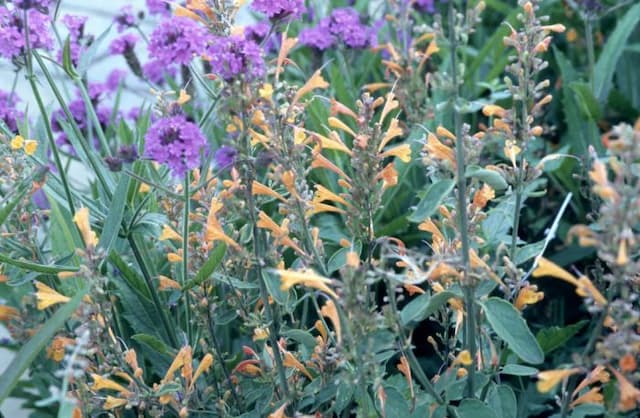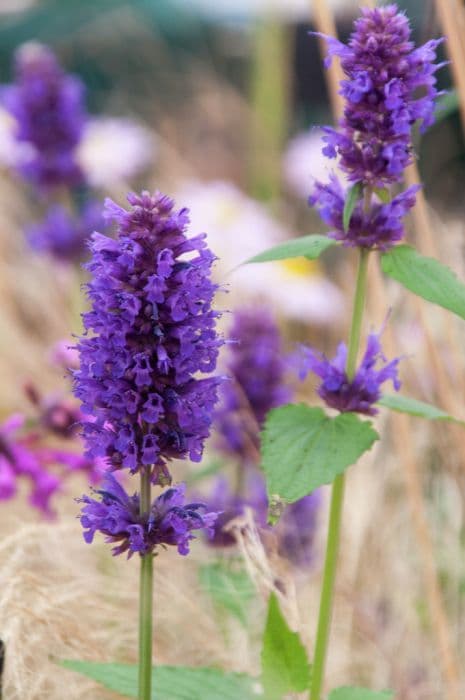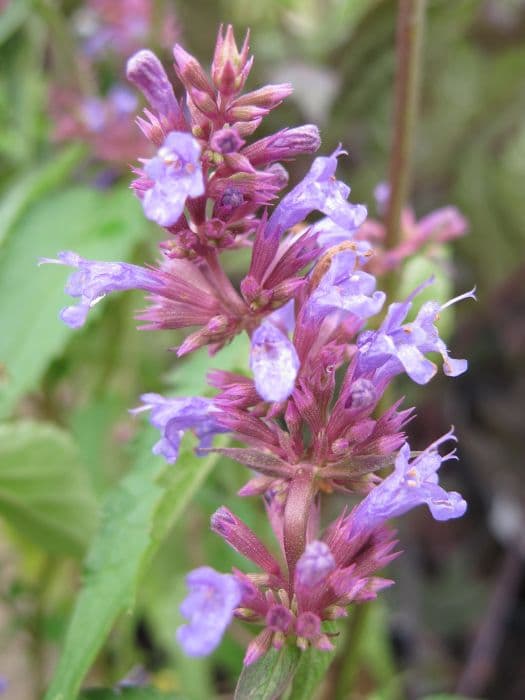Fernleaf Lavender Lavandula pinnata

ABOUT
Lavandula pinnata, commonly known as fernleaf lavender, is a visually striking plant characterized by its distinct foliage and flowers. The leaves of this lavender variety are deeply dissected, resembling a fern's fronds, hence its common name. These leaves are typically gray to green in color, lending a soft, muted texture to the plant's overall appearance. The fernleaf lavender produces tall, upright flowering spikes that stand out against the lacy foliage. Atop these spikes sit whorls of small, vibrant purplish-blue flowers. Often the flowers have slender petals that project outwards, giving an almost butterfly-like appearance. The plant's blooms are noted for their exquisite color and are a significant source of attraction for pollinators like bees and butterflies. As with many lavender species, the fernleaf lavender is admired for its aromatic qualities. The scent emanates from both the flowers and the foliage, producing a strong, soothing fragrance characteristic of lavender plants. It is commonly grown for ornamental purposes in gardens and can be used for its fragrant flowers in aromatherapy, crafting, and as a naturally appealing insect repellent.
About this plant
 Names
NamesFamily
Lamiaceae
Synonyms
Fernleaf Lavender, Jagged Lavender
Common names
Lavandula pinnata.
 Toxicity
ToxicityTo humans
The most common common name of Lavandula pinnata is Fernleaf Lavender. Fernleaf Lavender is generally considered non-toxic to humans. However, it is important to note that while the plant is widely used in aromatherapy and cooking, excessive ingestion of any part of the plant may possibly lead to gastrointestinal discomfort or other mild reactions in some individuals due to the essential oils and compounds it contains.
To pets
Fernleaf Lavender, known as Lavandula pinnata, is typically considered non-toxic to pets. Unlike some other plants, Fernleaf Lavender does not generally pose a serious risk to dogs or cats. However, if a pet were to ingest a large amount of the plant, it could potentially experience mild gastrointestinal upset. It's always recommended to keep an eye on your pets and prevent them from eating large quantities of plants, including Fernleaf Lavender.
 Characteristics
CharacteristicsLife cycle
Perennials
Foliage type
Evergreen
Color of leaves
Green
Flower color
Purple
Height
2 feet [0.61 meters]
Spread
2 feet [0.61 meters]
Plant type
Shrub
Hardiness zones
9
Native area
Canary Islands
Benefits
 General Benefits
General Benefits- Aesthetic Appeal: Lavandula pinnata, commonly known as Fernleaf Lavender, adds beauty to gardens with its unique fern-like foliage and deep purple flowers.
- Aromatherapy: The plant emits a pleasant fragrance that can be calming and is often used in aromatherapy products.
- Culinary Uses: Fernleaf Lavender leaves and flowers can be used in cooking to add flavor to dishes, such as baked goods and desserts.
- Garden Companion: It is believed to help deter certain pests from garden areas, making it a beneficial companion plant.
- Attracts Pollinators: The flowers of Fernleaf Lavender attract bees, butterflies, and other beneficial pollinators, supporting biodiversity.
- Drought-Tolerance: As a Mediterranean native, it is well adapted to hot, dry climates, making it an excellent choice for water-wise gardens.
- Easy Maintenance: This plant is known for being low-maintenance, requiring minimal care once established in an appropriate environment.
 Medical Properties
Medical Properties- Anxiety relief: Lavender is commonly used for its calming and relaxing properties, which can help alleviate anxiety.
- Sleep improvement: Its soothing scent is believed to enhance sleep quality and help with insomnia.
- Pain relief: Lavender may have analgesic properties that can help reduce the perception of pain.
- Antiseptic uses: Due to its antimicrobial properties, lavender is sometimes used to help prevent infection and promote wound healing.
- Anti-inflammatory effects: It may help reduce inflammation and alleviate symptoms of conditions like arthritis.
- Headache relief: Inhalation of lavender scent might offer relief from headaches and migraines.
- Digestive aid: Lavender can be used to help with various digestive issues, like gas and bloating.
- Respiratory health: It might help alleviate symptoms of colds, flu, and other respiratory problems.
 Air-purifying Qualities
Air-purifying QualitiesThis plant is not specifically known for air purifying qualities.
 Other Uses
Other Uses- Lavender sachets: Lavandula pinnata can be dried and placed in sachets to impart a pleasant fragrance to closets, drawers, and laundry.
- Flavoring agent: Dried lavender flowers can add a unique floral flavor to baked goods, jams, and desserts.
- Aromatherapy: The essential oil from this plant can be used in diffusers to create a calming atmosphere in homes and workplaces.
- Crafts: Lavender stems and flowers can be incorporated into wreaths, bouquets, and other floral arrangements for decoration.
- Natural insect repellent: The scent of Lavender can deter mosquitoes and other insects, so bundles of the plant can be placed around windows and doors.
- Companion planting: Lavender plants can be grown in gardens to attract pollinators like bees and butterflies while possibly repelling certain pests.
- Signature scent creation: Lavender oil can be combined with other essential oils to craft personalized perfumes or colognes.
- Photography prop: The picturesque blooms of Lavandula pinnata make it a popular choice for photographers seeking to add natural beauty to their compositions.
- Textile freshener: A few drops of lavender oil on fabric items like curtains or pillows can keep them smelling fresh.
- Soil conditioner: When Lavandula pinnata is used as green manure, it can improve soil health and structure after its life cycle has ended.
Interesting Facts
 Feng Shui
Feng ShuiThe Lavender is not used in Feng Shui practice.
 Zodiac Sign Compitability
Zodiac Sign CompitabilityThe Lavender is not used in astrology practice.
 Plant Symbolism
Plant Symbolism- Calmness: Lavandula pinnata, commonly known as fernleaf lavender, is often associated with calmness due to lavender's widely recognized relaxing and soothing properties.
- Purity: Lavender has historical ties to cleanliness and purity, as it was used in past times for its antiseptic qualities and added to wash water.
- Devotion: The plant is also a symbol of devotion, representing a deep and enduring connection or commitment.
- Silence: Fernleaf lavender embodies the idea of silence, possibly due to its calming effects that can quiet the mind and encourage peacefulness.
- Healing: Lavender is commonly used in aromatherapy and herbal remedies for its purported healing effects on both the body and mind.
 Water
WaterThe fernleaf lavender should be watered sparingly, as it is drought-tolerant and prefers a well-draining soil to prevent root rot. During the growing season, water when the soil feels dry to the touch, about once every 1-2 weeks, with approximately 1 gallon per plant to ensure deep watering. During the winter months, reduce watering frequency to once every 2-3 weeks as the plant's water requirements decrease. Over-watering is a common issue, so it's important to let the soil dry out slightly between waterings.
 Light
LightFernleaf lavender thrives in full sunlight, needing at least 6 to 8 hours of direct sun each day. The best spot for this plant would be a south-facing garden bed or a location where it can receive uninterrupted sunlight throughout the day. This plant does not fare well in shaded areas as it can lead to poor blooming and weak growth.
 Temperature
TemperatureFernleaf lavender does best in warmer climates and can tolerate a temperature range from 40°F to 100°F, with the ideal temperature being between 60°F and 80°F. It's hardy to USDA zone 8, but in regions where temperatures drop below freezing, it should be grown in containers and brought indoors to protect it from extreme cold.
 Pruning
PruningPruning fernleaf lavender promotes healthy growth and prevents the plant from becoming woody and sparse. Prune back the plant by one-third to one-half after blooming in late summer or early fall, which encourages new growth and a second bloom in regions with a long growing season. It's also beneficial to remove any dead or damaged stems to maintain plant vigor and appearance.
 Cleaning
CleaningAs needed
 Soil
SoilThe best soil mix for Lavender Fernleaf (Lavandula pinnata) should be well-drained and sandy with a neutral to slightly alkaline pH, ideally between 6.5 and 8. A combination of two parts coarse sand or perlite with one part compost or organic matter will provide the appropriate texture and nutrients.
 Repotting
RepottingLavender Fernleaf (Lavandula pinnata) typically requires repotting every 2 to 3 years to refresh the soil and accommodate root growth. It's best to repot in spring just before new growth begins.
 Humidity & Misting
Humidity & MistingLavender Fernleaf (Lavandula pinnata) thrives in low to medium humidity levels; it is tolerant of dry air and does not require high humidity to prosper.
 Suitable locations
Suitable locationsIndoor
Ensure full sun, well-drained soil, infrequent watering for indoor Lavender Fernleaf.
Outdoor
Place in full sun, well-draining soil, low water, protect from harsh winter.
Hardiness zone
8-11 USDA.
 Life cycle
Life cycleThe life cycle of Lavandula pinnata, commonly known as Fernleaf Lavender, begins with seed germination, which requires well-drained soil and plenty of sunlight. Upon sprouting, the seedlings develop into young plants with characteristic feathery, fern-like leaves. As the plant matures, it enters its vegetative growth stage characterized by the expansion of foliage and strengthening of stems. The next stage is the flowering period, during which Fernleaf Lavender produces tall spikes with multiple purple flowers that attract pollinators and are prized for their fragrance. After pollination, the flowers develop into seed pods, completing the reproductive cycle. The plant then enters a period of dormancy, typically in response to colder temperatures, where growth slows down until favorable conditions return.
 Propogation
PropogationPropogation time
Spring-Early Summer
The most popular method of propagating Lavandula pinnata, commonly known as Jagged Lavender or Fern Leaf Lavender, is through softwood cuttings. The best time for this is late spring to early summer when the plant's new growth is abundant and the stems are not yet fully matured. To propagate Jagged Lavender via cuttings, one should select healthy, non-flowering stems and cut a 3 to 4-inch (approximately 7.5 to 10 cm) length, making the cut just below a leaf node. The lower leaves are then removed, and the cut end can be dipped in rooting hormone to encourage root development. The prepared cutting is then placed into a well-draining potting mix, ensuring that the leaf nodes where the leaves were removed are buried. The cutting should be kept moist and in a warm environment with indirect sunlight until roots have established, typically within a few weeks. Once rooted, the new Jagged Lavender plants can be transplanted into individual pots or an appropriate site in the garden.







![Bugle [Black Scallop]](/_next/image?url=https%3A%2F%2Fplants-admin.emdemapps.com%2Fimages%2Fplants%2F%2Fimages%2F604b624330cd1.png&w=640&q=75)

